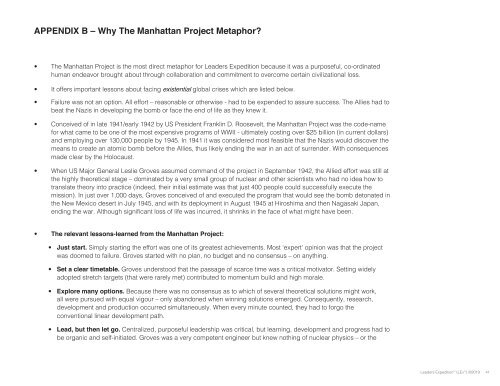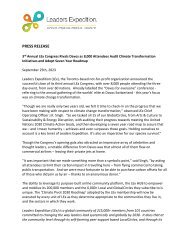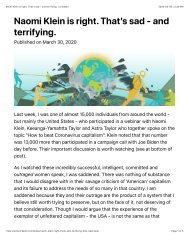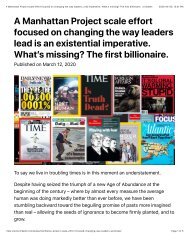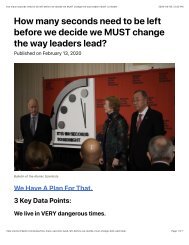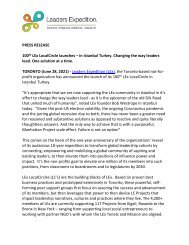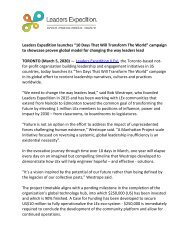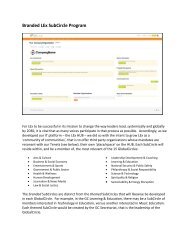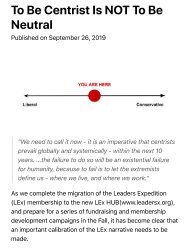LEx Case for Funding 1.30.20
This was the last document describing the LEx value proposition, and making the case to fund it. This 23 minute video is the (optional) compliment to the document: https://youtu.be/9B1Ud9PWeDw
This was the last document describing the LEx value proposition, and making the case to fund it.
This 23 minute video is the (optional) compliment to the document: https://youtu.be/9B1Ud9PWeDw
You also want an ePaper? Increase the reach of your titles
YUMPU automatically turns print PDFs into web optimized ePapers that Google loves.
APPENDIX B – Why The Manhattan Project Metaphor?<br />
•The Manhattan Project is the most direct metaphor <strong>for</strong> Leaders Expedition because it was a purposeful, co-ordinated<br />
human endeavor brought about through collaboration and commitment to overcome certain civilizational loss.<br />
• It offers important lessons about facing existential global crises which are listed below.<br />
• Failure was not an option. All ef<strong>for</strong>t – reasonable or otherwise - had to be expended to assure success. The Allies had to<br />
beat the Nazis in developing the bomb or face the end of life as they knew it.<br />
• Conceived of in late 1941/early 1942 by US President Franklin D. Roosevelt, the Manhattan Project was the code-name<br />
<strong>for</strong> what came to be one of the most expensive programs of WWII - ultimately costing over $25 billion (in current dollars)<br />
and employing over 130,000 people by 1945. In 1941 it was considered most feasible that the Nazis would discover the<br />
means to create an atomic bomb be<strong>for</strong>e the Allies, thus likely ending the war in an act of surrender. With consequences<br />
made clear by the Holocaust.<br />
• When US Major General Leslie Groves assumed command of the project in September 1942, the Allied ef<strong>for</strong>t was still at<br />
the highly theoretical stage – dominated by a very small group of nuclear and other scientists who had no idea how to<br />
translate theory into practice (indeed, their initial estimate was that just 400 people could successfully execute the<br />
mission). In just over 1,000 days, Groves conceived of and executed the program that would see the bomb detonated in<br />
the New Mexico desert in July 1945, and with its deployment in August 1945 at Hiroshima and then Nagasaki Japan,<br />
ending the war. Although significant loss of life was incurred, it shrinks in the face of what might have been.<br />
• The relevant lessons-learned from the Manhattan Project:<br />
• Just start. Simply starting the ef<strong>for</strong>t was one of its greatest achievements. Most ‘expert’ opinion was that the project<br />
was doomed to failure. Groves started with no plan, no budget and no consensus – on anything.<br />
• Set a clear timetable. Groves understood that the passage of scarce time was a critical motivator. Setting widely<br />
adopted stretch targets (that were rarely met) contributed to momentum build and high morale.<br />
• Explore many options. Because there was no consensus as to which of several theoretical solutions might work,<br />
all were pursued with equal vigour – only abandoned when winning solutions emerged. Consequently, research,<br />
development and production occurred simultaneously. When every minute counted, they had to <strong>for</strong>go the<br />
conventional linear development path.<br />
• Lead, but then let go. Centralized, purposeful leadership was critical, but learning, development and progress had to<br />
be organic and self-initiated. Groves was a very competent engineer but knew nothing of nuclear physics – or the<br />
Leaders Expedition TM (<strong>LEx</strong> TM ) ©2019 41


